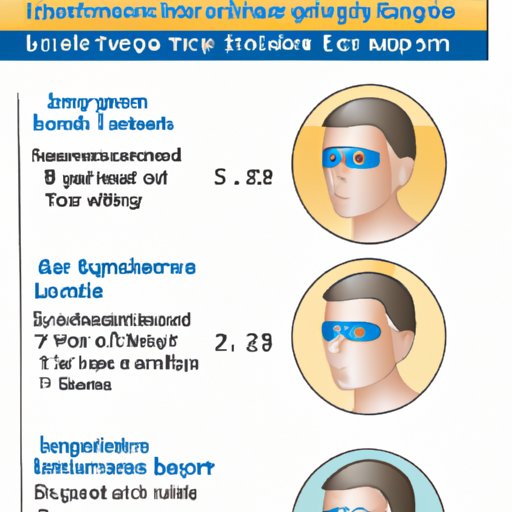
Introduction
Are you tired of relying on glasses or contacts to see? Lasik surgery may be the solution you’re looking for. This procedure can correct your vision and eliminate your need for corrective lenses. However, not everyone is eligible for this surgery, and many people wonder about the age requirements for getting lasik. In this article, we’ll explore the different age groups and their candidacy, the minimum age for lasik surgery, preparation guidelines, and what to expect during and after the procedure.
Scope of Lasik Surgery for Different Age Groups
The suitability for lasik surgery for each age group depends on various factors such as the overall eye health, prescription, stability, and visual needs. Candidates should be over the age of 18 and have a stable prescription for at least one year. Adults over 40 should also consider other procedures, such as monovision or Presbyond, which can correct age-related vision difficulties like seeing close up (presbyopia).
The risks involved and outcomes of lasik surgery differ depending on age. For example, younger candidates might have a better result due to their faster healing capability and lower risk of age-related eye conditions. On the other hand, older candidates might experience more complications due to the higher prevalence of cataracts, glaucoma, or dry eye syndrome associated with aging.
It’s crucial to have a proper evaluation with an eye doctor to determine the best procedure for the individual.
Exploring the Minimum Age for Lasik Surgery
The FDA has approved lasik surgery for those aged 18 and above. The minimum age requirement stems from the fact that a person’s eyes typically stop developing around 18 to 20 years old. Undergoing lasik surgery before the eyes reach stability could mean needing an additional corrective surgery later in life. Minors with severe vision difficulties or eye diseases may sometimes be eligible for photorefractive keratectomy (PRK), another type of laser vision correction that does not require a flap cut.
If you’re under 18 but considering vision correction surgery, consult with an eye doctor to determine the best course of action. There are other alternatives to lasik surgery, such as orthokeratology lenses or refractive surgeries that don’t require laser treatment, that may be safer for younger eyes.
Lasik Surgery for Adults and Seniors
Studies have shown that lasik surgery can be equally successful and safe for adults and seniors. However, differentiating between the two groups of adults and seniors can help determine the best procedure. Adults aged 18 to 40 typically have a stable prescription making them suitable candidates for lasik surgery. On the other hand, seniors may require additional procedures such as cataract surgery, which can be combined with lasik or another laser eye surgery.
The procedure also differs depending on the individual’s visual needs. For seniors, the need for vision correction evolves over time due to age-related changes in the eyes. An experienced eye doctor or surgeon can tailor the procedure to their specific vision needs and health conditions.
A Guide to Preparing for Lasik Surgery
Preparing for lasik surgery involves several steps, including a comprehensive eye exam, discussing eligibility, discussing risks, and pre-operative instructions. Plan for at least two consultations: one to discuss candidacy and the other to ask questions after a thorough evaluation. Pre-surgery instructions typically include stopping the use of contact lenses, avoiding eye makeup or creams, and arranging for someone to take you home after the procedure. Younger candidates may need additional screening tests to evaluate eye health thoroughly.
What to Expect: A Comprehensive Guide on Lasik Surgery
The lasik surgery procedure usually takes about 30 minutes for both eyes, with the actual laser part taking less than a minute and is typically painless if numbing eye drops are used. The entire process begins with putting numbing eye drops. Next, a device will hold your eye in place, and a thin flap will be created with a femtosecond laser to expose the cornea. The laser will then reshaped the exposed area, and the flap is repositioned, acting as a natural bandage. After the surgery, the surgeon will provide instructions for post-operative care, which typically includes using eye drops and avoiding water, dust, and other irritants for a few days. The recovery rate varies depending on age, with older patients taking longer to heal.
The potential risks of lasik surgery include dry eye syndrome, halos, glare, and infection. However, serious complications are exceptionally rare, and most side effects are temporary and self-limiting. Following pre-operative instructions and post-surgery care is essential to minimize the risk of complications and ensure the best outcome.
Conclusion
In conclusion, lasik surgery can be a safe and effective way to improve your vision by reducing or eliminating the need for corrective lenses. However, age is a crucial factor that determines candidacy and outcomes. It’s essential to discuss eligibility, risks, and expected outcomes with an experienced eye doctor to determine the best course of action. If you’re considering lasik surgery, prepare yourself thoroughly, following pre-operative instructions, and post-operative advice. Understanding the requirements and procedures involved in lasik surgery is essential to ensure the best outcome and reduce potential risks.




